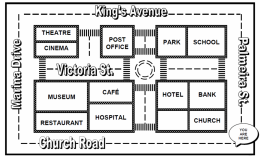Questões de Concurso Sobre inglês
Foram encontradas 19.451 questões


Bill: Why aren’t you coming out tonight? Zachary: Because I don’t have any money. If I ______, I with you Bill: Well, what about the movies tomorrow? Zachary: It depends. If my parents _____ me some money, ______ I . Bill: You always have an excuse! Why didn’t you come to Josh?s party last week? Zachary: I didn’t come because I lost my wallet and all my money. If I _____ my wallet, of course I _____ !


Go ahead in Church Road direction, turn right in Marina Drive, turn right in King´s Avenue. Then, after the theatre, turn right again in Victoria St., and you can appreciate Da Vinci´s masterpieces at the ______.

Smokey Joe is _____ Skinny Bones. In fact, Chuck Scarface is ______ and Skinny Bones is ______ of the gang. Scarface is ______ of the three men. Skinny Bones is ______ Smokey Joe. Skinny Bones is ______ whereas Scarface is ______ of all. This gang is very dangerous. Scarface is ______ Smokey Joe. But be careful, because Skinny Bones is ______. Scarface is ______ Smokey Joe. However, Skinny Bones is a very clever thief. He is ______ of the gang. Scarface works ______ Skinny Bones but Smokey Joe is ______ thief the police has ever met! But he is quite rich though. He is ______ Scarface. In fact, Scarface is ______ and Skinny Bones is ______ of the gang. The police say that Skinny Bones is ______ and ______ criminal they have ever met! Due to his intelligence, he is ______ thief to catch! These are ______ criminals in Liverpool!
 Disponível em >https://www.instagram.com/funny.english.memes/?hl=pt-br
Disponível em >https://www.instagram.com/funny.english.memes/?hl=pt-br  EASTWOOD, John. A basic English grammar exercises.
EASTWOOD, John. A basic English grammar exercises. Text 3A9-I
Amazon said Monday it will begin selling the cashierless checkout technology that powers its Go stores to other retailers. The “Just Walk Out” technology enables shoppers to “take what they want and leave” without the need to stop and stand in a checkout line. Cameras and other sensors through the store monitor which items shoppers take with them and charge them automatically when they leave.
Amazon told CNBC it has already inked several deals with retailers interested in bringing the cashierless technology to their stores. An Amazon spokesperson declined to comment on which companies plan to use the technology or how much Amazon is charging them to use it. Amazon said it takes a few weeks for it to install the cashierless technology in retailers’ stores, depending on whether it’s being implemented in a new or existing store. For existing stores, Amazon said it will “work with retailer to install the technology while minimizing impact on current operations.”
Unlike at Amazon Go stores, where users scan the Go app on a turnstile when they enter, shoppers scan their credit card on the turnstile at a store with the Just Walk Out technology. If shoppers need a receipt, they can visit a kiosk at the store and enter their email address, Amazon said. A receipt will be automatically sent to their email address the next time they visit any store with the cashierless technology.
Amazon can tailor marketing and gain valuable insights into customer purchasing habits by tracking activity at its Go stores. However, Amazon said it won’t collect any other user data beyond a shopper’s email in order to send receipts. “Shoppers can think of this as similar to typical security camera footage,” Amazon added.
The move comes as Amazon continues to build out its network of 25 Go stores across the country. Last month, Amazon launched its first, full-size, cashierless supermarket, called Go Grocery, not far from its Seattle headquarters. CNBC previously reported Amazon is considering bringing the technology to airport shops and movie theaters.
Amazon said its Go stores will begin acccaepting cash last year after the company came under fire for discriminating against the unbanked. Amazon told CNBC it will be up to retailers to decide whether they want to accept cash at stores that license the company’s Just Walk Out technology. Some states, like New Jersey, have new laws banning stores that don’t accept cash.
Internet: <www.cnbc.com> (adapted).
Text 3A9-I
Amazon said Monday it will begin selling the cashierless checkout technology that powers its Go stores to other retailers. The “Just Walk Out” technology enables shoppers to “take what they want and leave” without the need to stop and stand in a checkout line. Cameras and other sensors through the store monitor which items shoppers take with them and charge them automatically when they leave.
Amazon told CNBC it has already inked several deals with retailers interested in bringing the cashierless technology to their stores. An Amazon spokesperson declined to comment on which companies plan to use the technology or how much Amazon is charging them to use it. Amazon said it takes a few weeks for it to install the cashierless technology in retailers’ stores, depending on whether it’s being implemented in a new or existing store. For existing stores, Amazon said it will “work with retailer to install the technology while minimizing impact on current operations.”
Unlike at Amazon Go stores, where users scan the Go app on a turnstile when they enter, shoppers scan their credit card on the turnstile at a store with the Just Walk Out technology. If shoppers need a receipt, they can visit a kiosk at the store and enter their email address, Amazon said. A receipt will be automatically sent to their email address the next time they visit any store with the cashierless technology.
Amazon can tailor marketing and gain valuable insights into customer purchasing habits by tracking activity at its Go stores. However, Amazon said it won’t collect any other user data beyond a shopper’s email in order to send receipts. “Shoppers can think of this as similar to typical security camera footage,” Amazon added.
The move comes as Amazon continues to build out its network of 25 Go stores across the country. Last month, Amazon launched its first, full-size, cashierless supermarket, called Go Grocery, not far from its Seattle headquarters. CNBC previously reported Amazon is considering bringing the technology to airport shops and movie theaters.
Amazon said its Go stores will begin acccaepting cash last year after the company came under fire for discriminating against the unbanked. Amazon told CNBC it will be up to retailers to decide whether they want to accept cash at stores that license the company’s Just Walk Out technology. Some states, like New Jersey, have new laws banning stores that don’t accept cash.
Internet: <www.cnbc.com> (adapted).

Internet: <https://www.nytimes.com/>

Internet: <https://www.nytimes.com/>

Internet: <https://www.nytimes.com/>

Internet: <https://www.nytimes.com/>

Internet: <https://www.nytimes.com/>